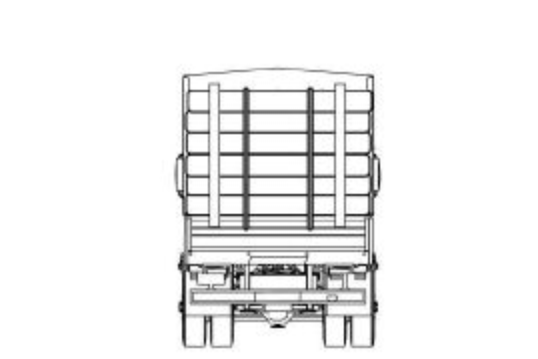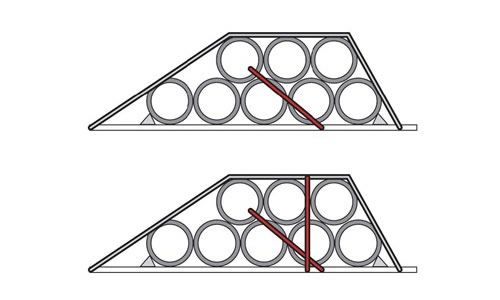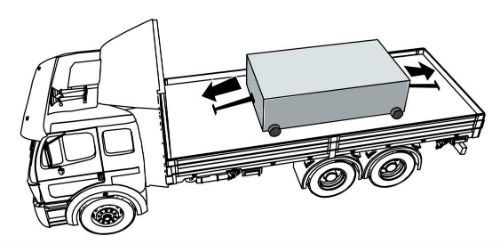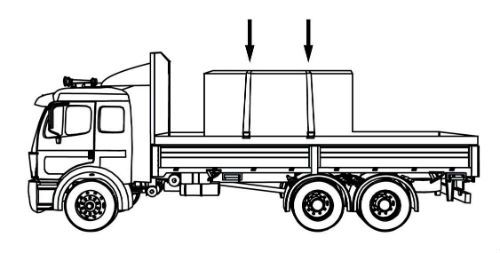CDL Practice Tests: Flatbed Cargo Securement
Choose A Section:
Go!All of these are requirements for securing longwood lengthwise except:
- Must be cradled in two or more bunks or contained by stakes.
- Each end of the log should extend at least 3 inches beyond the stakes.
- Secure each log with at least two tiedowns if shorter logs are carried on top of the stack.
- Each outside log should bear against at least two stakes, one near each end of the log.
Requirements for securing longwood loaded lengthwise
- Longwood must be cradled in two or more bunks or contained by stakes.
- Each outside log should bear against at least two stakes, one near each end of the log.
- Each end of the log should extend at least 0.15 m (6 in) beyond the stakes.
- If shorter logs are carried on top of the stack, secure each log with at least two tiedowns.
How many tiedowns are required on a stack of shortwood loaded crosswise?
- 1
- 3
- 2
- It depends on the weight
Tiedowns requirements

Use two tiedowns to secure one stack of shortwood loaded crosswise.
Attach the tiedowns to the vehicle frame at the front and rear of the load.
Position tiedowns approximately 1/3 and 2/3 of the length of the logs.
How many knots are acceptable in a properly working tiedown?
- 0
- 3
- 1
- 2
All components of a tiedown must be in proper working order.
- No knots or obvious damage
- No distress
- No weakened parts
- No weakened sections
What is the minimum requirement for securing roll-off and hook containers?
- Two hooks, or an equivalent mechanism, securing both sides of the container to the vehicle chassis.
- All of these are acceptable.
- Two tiedowns installed lengthwise, each securing one side of the container to one of the vehicle's side rails.
- One tiedown attached to both the vehicle chassis and the container chassis.
Secure to the rear of the vehicle with at least one of the following three mechanisms:
-
Rear Mechanism 1:
One tiedown attached to both the vehicle chassis and the container chassis.
-
Rear Mechanism 2:
Two tiedowns installed lengthwise, each securing one side of the container to one of the vehicle's side rails.
-
Rear Mechanism 3:
Two hooks, or an equivalent mechanism, securing both sides of the container to the vehicle chassis at least as effectively as the tiedowns in the two previous items.
The North American Cargo Securement Standard cover vehicles weighing:
- Over 10,000 lbs
- Less than 10,000 lbs
- 26,001 lbs
- Over 4,500 lbs
North American Cargo Securement Standard
What does the Standard cover? (Section 1.1)
- Commercial vehicles (including a combination of vehicles) that are operated on a highway and have a gross vehicle rating over 4,500 kg (10,000 lb.)
Vehicles
Working Load Limit (WLL)is defined as:
- The number of hours that a tiedown can be used.
- The maximum load that may be applied to a component of a cargo securement system during normal service, usually assigned by the manufacturer of the component.
- The acceleration due to gravity, 9.823 m/sec2 (32.2 ft/sec2).
- The summation of the working load limits or restraining capacity of all devices used to secure an article on a vehicle.
Working Load Limit (WLL):
The maximum load that may be applied to a component of a cargo securement system during normal service, usually assigned by the manufacturer of the component.
A bulkhead is defined as:
- A vertical barrier across a vehicle to prevent forward movement of cargo.
- A vertical barrier placed directly behind the cab of a tractor to protect the cab in the event cargo should shift forward.
- A structure, device, or another substantial article placed against or around an article to prevent horizontal movement of the article.
- A vertical barrier across the front of the deck of a vehicle to prevent forward movement of cargo.
Bulkhead:
A vertical barrier across a vehicle to prevent forward movement of cargo.
What is the maximum angle recommended for tiedowns securing cement pipe loaded crosswise, relative to the deck?
- 45-90 degrees
- 180 degrees
- 45 degrees
- It doesn't matter
If the first pipe of a group in the top tier is not at the front of the tier beneath:

Attach an additional tiedown that runs rearward at an angle not more than 45 to the horizontal when viewed from the side of the vehicle, whenever practical.
Pass tiedown either through the front pipe of the upper tier or outside the front pipe and over both longitudinal tiedowns.
As part of their pre-trip cargo securement inspection, drivers should:
- Check for anything that will obscure their vision.
- Make sure cargo is properly secured.
- Inform carrier of any inadequate packaging.
- All of these apply.
Driver inspection checklist:
Pre-Trip
- Make sure that cargo is properly distributed and adequately secured (in other words, according to the Standard).
- Make sure that all securement equipment and vehicle structures are in good working order and used consistent with their capability.
- Stow vehicle equipment.
- Make sure that nothing obscures front and side views or interferes with the ability to drive the vehicle or respond in an emergency.
-
Inform carrier if packaging is not adequate. For example:
- Banding is loose or not symmetrical on package.
- Banding attachment device(s) are inefficient.
- Wrapping is broken or ineffective.
- Pallets are broken.
When loading paper rolls with eyes horizontal, which of the following is not a requirement for stacking a second layer:
- All the wells in the layer beneath must be filled
- Place second layer with eyes vertical.
- The bottom layer must extend all the way to the front.
- It must be blocked against an eye-vertical blocking roll resting on the floor of the vehicle that is at least 1.5 times taller than the diameter of the roll being blocked.
Requirements for eyes crosswise: secure stacks of paper rolls from front-to-back movement
- Do not load paper rolls on a second layer unless the bottom layer extends to the front of the vehicle.
- Load paper rolls on higher layers only if all wells in the layer beneath are filled.
-
Secure the foremost roll in each upper layer (or any roll with an empty well in front of it) against forward movement:
- Either by placing it in a well formed by two rolls on the lower row whose diameter is equal to or greater than that of the roll on the upper row.
- Or by banding it to other rolls.
- Or by blocking it against an eye-vertical blocking roll resting on the floor of the vehicle that is at least 1.5 times taller than the diameter of the roll being blocked.
About The Flatbed Cargo Securement CDL Manual
Studying the flatbed cargo securement CDL manual is not a requirement for getting your CDL permit or license. It is required knowledge for flatbed drivers.
Some questions you should be able to answer for flatbed cargo securement:
- What is the minimum Working Load Limit of a tiedown used to secure logs?
- What is the minimum weight of a shipment of paper rolls that would require specific securement requirements?
- When securing concrete pipe over 45 inches loaded crosswise, which direction must the tiedowns on the front half of the load run?
- What is a cab shield?
- When securing concrete pipe over 45 inches loaded crosswise, which direction must the tiedowns on the rear half of the load run?
- What is a dunnage bag?
- Who is responsible for inspecting securing devices and cargo within the first 50 miles?
- How many tiedowns are required on a stack of shortwood loaded crosswise?
- What is the minimum working load limit of each tiedown used to secure crushed or flattened vehicles?
- Define 'bolster'
- What is a hook-lift container?
- When a tiedown is attached directly to the cargo, what is the ideal angle where it attached to the vehicle?
What is a securing device?
Any device specifically manufactured to attach or secure cargo to a vehicle or trailer:
- Synthetic Webbing
- Chain
- Wire rope
- Manila rope
- Synthetic rope
- Steel strapping
- Clamps and latches
- Blocking
- Front-end structure
- Grab hooks
- Binders
- Shackles
- Winches
- Stake pockets
- D-rings
- Webbing ratchet
- Bracing
- Friction mat
What is a tiedown?
A combination of securing devices that forms an assembly that:
- Attaches cargo to, or restrains cargo on a vehicle.
- Is attached to anchor point(s).

Some tiedowns are attached to the cargo and provide direct resistance to restrain the cargo from movement.

Some tie-downs pass over or through the cargo. They create a downward force that increases the effect of friction between the cargo and the deck. This friction restrains the cargo.
 Related Cargo Securement Terms That Every Driver Should Know:
Related Cargo Securement Terms That Every Driver Should Know:
-
Tiedown:
A combination of securing devices which form an assembly that attaches cargo to, or restrains cargo on, a vehicle or trailer, and is attached to anchor point(s).
-
Contained:
Cargo is contained if it fills a sided vehicle, and every article is in contact with or sufficiently close to a wall or other articles so that it cannot shift or tip if those other articles are also unable to shift or tip.
-
Blocking:
A structure, device, or another substantial article placed against or around an article to prevent horizontal movement of the article.
How should tiedowns be attached?
Tiedowns can be used in two ways:
-
Attached to the cargo:
- Tiedowns attached to the vehicle and attached to the cargo.
- Tiedowns attached to the vehicle, pass through or aroundan article of cargo, and then are attached to the vehicle again.
-
Pass over the cargo:
- Tiedowns attached to the vehicle, passed over the cargo, and then attached to the vehicle again.
Tiedown placement:

Place the tiedown as close as possible to the spacer.
Position the tiedowns as symetrically as possible over the length of the article.

Position the tiedowns to preserve the integrity of the article.







 TT On Facebook
TT On Facebook